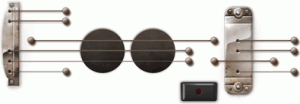 When Google earlier this month designed its logo as a guitar to honor legendary musician Les Paul, the search giant demonstrated how a changing look can enhance the power of a brand. On Google’s home page, users could actually strum the guitar, record their “performance” and email the recording to friends.
When Google earlier this month designed its logo as a guitar to honor legendary musician Les Paul, the search giant demonstrated how a changing look can enhance the power of a brand. On Google’s home page, users could actually strum the guitar, record their “performance” and email the recording to friends.
The guitar was the latest of about 1,000 iterations (see an archive here) of the Google logo that have appeared in the U.S. and internationally over the years, created to honor birthdays of the famous, civic milestones, festivals and pretty much anything else the Google Doodle team fancies. In recent months, the logo has celebrated yesterday’s lunar eclipse, Italy’s Republic Day, dancer and choreographer Martha Graham’s 117th birthday and the Dragon Boat Festival in China, Hong Kong, Taiwan and Singapore.
In a world where companies spend millions to design and protect their logos, Google’s so-called Doodle is “extremely bold and very clever,” according to Wharton marketing professor David Reibstein. “They probably feel they can do it because their brand is so well known and so pervasive. They have the latitude to do what most companies would never dare to do.”
Wal-Mart, for example, has had just six logos in the past 50 years. But Google can keep changing its logo design because it is a web-based company that people log on to every day, say Reibstein and fellow Wharton marketing professor Jonah Berger. “[The logo] is drawing people to look at it because it is changing,” Berger notes. “People will wonder what it will be today and what it will be tomorrow. It gets much more attention than it would get otherwise.” A company like Yahoo could do something similar, Berger adds, but firms such as General Electric or Ford would find a changing logo difficult to pull off because “people wouldn’t necessarily go to those websites every day.”
Yet, Google’s Doodle is also about consistency. The logo may change regularly, but it almost always maintains the signature rainbow colors, says Reibstein, noting exceptions such as on Earth Day (April 22), when it turned green, or the black-and-white guitar design for Les Paul. In the case of a company like Wal-Mart, a logo change may denote “a change from one [strategy] to the next,” Reibstein notes, but Google hasn’t changed its brand with its logo design. “This is their representation du jour.”
Berger gives Google credit for “taking something most people take for granted, or don’t pay attention to, and changing it.” A few other brands have taken that path occasionally, such as Nike, which has used different colors for its famous “swoosh” symbol. Snickers, too, launched an ad campaign several years ago that employed its iconic logo style, but substituted hunger-related words like “nougetaboutit” for the candy bar’s name, Reibstein recalls.
Sergey Brin, Google’s co-founder, has a patent for the Doodle, which is put together by a design team led by graphic artist Dennis Hwang. The Doodle was born in 1998, when Brin and Google co-founder Larry Page changed the corporate logo to indicate that they would be out of office attending the Burning Man festival in Nevada.
Google Doodles aren’t paying off for everyone, however. Technology website ExtremeTech estimates that the Les Paul Google Doodle cost companies around the world US$268 million in lost productivity, citing data from RescueTime, a Seattle, Wash.-based web analytics firm. The site arrived at that number assuming Google’s 740 million daily visitors spent 26 seconds more than normal on Google in the two days the Les Paul Doodle was online.


